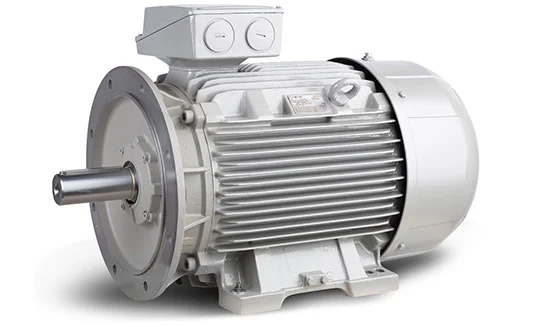

Electric motors are the most important type of electric load in every industry. An electrical motor is an electromechanical device which converts electrical energy into mechanical energy. In other words, the devices which produce rotational force are known as the motor. The working principle of the electric motor mainly depends on the interaction of magnetic and electric fields. The electric motor is mainly classified into two types: the AC motor and the DC motor. The AC motor takes alternating current as an input, whereas the DC motor takes direct current.
In AC electric motor, the most popular motor is single phase and three-phase AC Induction motor. In three-phase AC (Alternating Current) operation, the most widely used motor is a 3 phase induction motor, as this type of motor does not require an additional starting device. These types of motors are known as self-starting induction motors.
Three-phase induction motors are used extensively in domestic and industrial appliances because these are rugged in construction requiring little to no maintenance, comparatively cheaper, and require supply only to the stator. The motor-driven systems account for about seventy per cent of the energy consumed by the industry. There is a large potential for cost- effective solutions in the use of energy-efficient motor systems, by about twenty to thirty per cent. Electric motor systems include several energy-using products, such as motors, drives, pumps or fans, compressors, blowers and other machines. Energy efficient motors form a major component in contributing to energy saving by way of increased efficiency of the product itself.
Applications of Three Phase Induction Motor include lifts, cranes, hoists, large capacity exhaust fans etc.
Internationally, forty-one countries representing 76% of the energy consumed by motor systems have worked to transform their national markets towards high-efficiency motors and motor systems through a combination of regulatory measures and supporting policies. The majority of these countries have already adopted IE2 long back, few have progressed to make IE3 as MEPS.
Indian Standard on Energy Efficient Induction Motor
In India, IS 12615: 2018 covers the efficiency classes and performance specifications of single-speed line-operated AC motors. IS 12615 was brought under mandatory certification with effect from 1st October 2017 vide Energy Efficient Induction Motors Three Phase Squirrel Cage (Quality Control) order, 2017 issued by DIPP. It has certainly raised the bar for improving efficiency standards for Motors in India. Eventually, the demand and usage of IE2 & above motors have increased.
IS 12615 specifies the values of Performance Characteristics such as full load speed, full load current, locked torque in terms of full load torque, locked rotor current in terms of full load current, nominal efficiency for 2, 4, 6 & 8 poles motors which ensures the quality and performance of induction motors. It defines three energy efficiency levels: IE2, IE3, and IE4.
Important Test Requirements
The essential tests performed on motors to assess their quality and performance are as follows:
a) Insulation Resistance Test
b) No Load Test
c) High Voltage Test
d) Locked Rotor Test
e) Temperature Rise Test
f) Noise Test
g) Over speed Test
It is well known that environment and efficiency are interlinked with each other. Therefore, an increase in efficiency in the motor will result in large energy savings and a reduction in CO2 emissions into our environment.
Electric motors are the most important type of electric load in every industry. An electrical motor is an electromechanical device which converts electrical energy into mechanical energy. In other words, the devices which produce rotational force are known as the motor. The working principle of the electric motor mainly depends on the interaction of magnetic and electric fields. The electric motor is mainly classified into two types: the AC motor and the DC motor. The AC motor takes alternating current as an input, whereas the DC motor takes direct current.
In AC electric motor, the most popular motor is single phase and three-phase AC Induction motor. In three-phase AC (Alternating Current) operation, the most widely used motor is a 3 phase induction motor, as this type of motor does not require an additional starting device. These types of motors are known as self-starting induction motors.
Three-phase induction motors are used extensively in domestic and industrial appliances because these are rugged in construction requiring little to no maintenance, comparatively cheaper, and require supply only to the stator. The motor-driven systems account for about seventy per cent of the energy consumed by the industry. There is a large potential for cost- effective solutions in the use of energy-efficient motor systems, by about twenty to thirty per cent. Electric motor systems include several energy-using products, such as motors, drives, pumps or fans, compressors, blowers and other machines. Energy efficient motors form a major component in contributing to energy saving by way of increased efficiency of the product itself.
Applications of Three Phase Induction Motor include lifts, cranes, hoists, large capacity exhaust fans etc.
Internationally, forty-one countries representing 76% of the energy consumed by motor systems have worked to transform their national markets towards high-efficiency motors and motor systems through a combination of regulatory measures and supporting policies. The majority of these countries have already adopted IE2 long back, few have progressed to make IE3 as MEPS.
Indian Standard on Energy Efficient Induction Motor
In India, IS 12615: 2018 covers the efficiency classes and performance specifications of single-speed line-operated AC motors. IS 12615 was brought under mandatory certification with effect from 1st October 2017 vide Energy Efficient Induction Motors Three Phase Squirrel Cage (Quality Control) order, 2017 issued by DIPP. It has certainly raised the bar for improving efficiency standards for Motors in India. Eventually, the demand and usage of IE2 & above motors have increased.
IS 12615 specifies the values of Performance Characteristics such as full load speed, full load current, locked torque in terms of full load torque, locked rotor current in terms of full load current, nominal efficiency for 2, 4, 6 & 8 poles motors which ensures the quality and performance of induction motors. It defines three energy efficiency levels: IE2, IE3, and IE4.
Important Test Requirements
The essential tests performed on motors to assess their quality and performance are as follows:
a) Insulation Resistance Test
b) No Load Test
c) High Voltage Test
d) Locked Rotor Test
e) Temperature Rise Test
f) Noise Test
g) Over speed Test
It is well known that environment and efficiency are interlinked with each other. Therefore, an increase in efficiency in the motor will result in large energy savings and a reduction in CO2 emissions into our environment.

Neha Agarwal
Scientist-C (ETD)